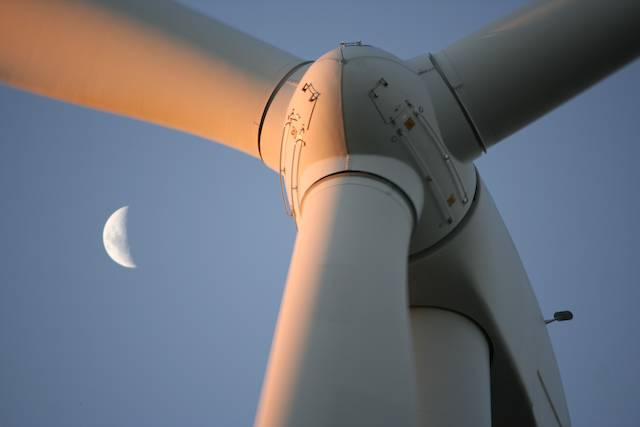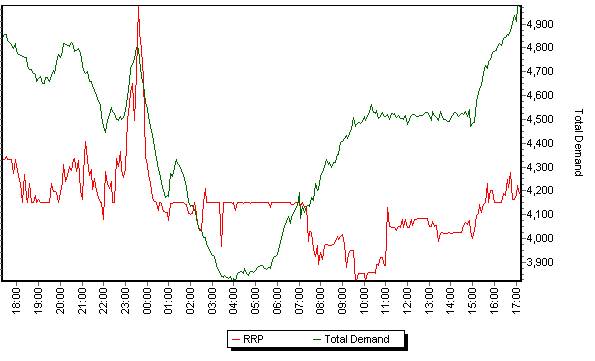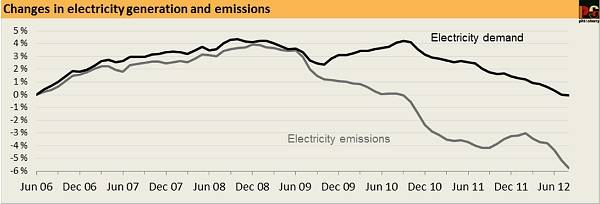Cape Bridgewater Wind Farm noise report
"You can't say that noise affects health from this study"
On 2015/01/21 Graham Lloyd had a front page article in The Australian on
a report produced by acoustician Steven Cooper concerning the Bridgewater
Wind Farm and noise complaints.
Lloyd's article was headlined:
"PEOPLE living near wind farms face a greater risk of suffering health complaints caused by the low-frequency noise generated by turbines, a groundbreaking study has found."
|
Lloyd was writing about a 'study' that was based on only six self-selected subjects who claimed to be adversely affected by nearby wind turbines while over a hundred more were apparently unaffected by the turbines and not included in the study. The study was not peer-reviewed. The acoustician who did the study tried to relate vaguely defined 'sensations' to the wind turbines. The author of the study freely admitted that one of the subjects reported 'sensations' when the turbines were not operating.
Rather than give further air to Lloyd's poor reporting of the findings of a questionable report I will simply refer readers to a piece written by Jacqui Hoepner and Will J Grant and published in The Conversation on 2015/01/22. It was titled "Wind turbine studies: how to sort the good, the bad, and the ugly".
|
|
Graham Lloyd and Hamish Cumming
| ||
| ||
| ||
| ||
| ||
|
They say that, despite the wind farms that have been built, Victoria's coal-fired power stations have not generated any less greenhouse carbon dioxide. Lloyd wrote "fossil fuel generators, in the same periods when wind turbines had been operating, fluctuated their output to match demand but did not reduce their rate of coal consumption." What Lloyd and Cumming are implying, but not saying, is that the coal-fired power stations are so poorly designed or managed that they cannot reduce their rate of pollution, even when they are generating less power.
So far as I am aware, Lloyd and Cumming have not published any credible data supporting this claim.
Where Lloyd and Cumming get really creative and imaginative is in claiming that this is not any fault of the coal-fired power stations, but of the wind farms! Somehow we are to believe that the (claimed by Lloyd and Cumming) failure of Victoria's coal-fired power stations to reduce their emissions in response to reduced demand on their generation is all to be blamed on the wind power industry.
In fact, when generation from the wind farms is high, it is mainly generation from gas-fired power stations that is reduced. The marginal cost of power from Victoria's coal-fired power stations is very low, the more expensive gas-fired electricity is the first to go. Generally, coal-fired power stations are inflexible in their power output; gas-fired power stations are much more flexible; they produce greenhouse gasses too, just rather less than coal-fired power stations.
Even if as Mr Cumming claims, the Victorian coal-fired power stations are producing more greenhouse gasses in relation to electricity than they used to do, and his arguments on this point are unconvincing, it would not be a reason to drop wind power, but rather a reason to shut down coal fired power stations as quickly as possible and change to renewables with gas-fired power stations to fill the gaps until we can change entirely to renewables.
An article by Tristan Edis in Climate Spectator, 2013/02/01, showed by use of statistics that the brown coal-fired power stations of Victoria are not ramping up and down in response to wind power, as Mr Cumming claimed, but that gas-fired and black coal-fired generators are. This, in itself, makes nonsense of Mr Cumming's claims. If Victoria's brown coal-fired power stations are not responding to the variable output of wind farms how can any (alleged) increase in greenhouse gasses from them be due to the wind farms?
|
|
|
Wind power and total electrical demand
|
The graph on the right is typical of wind energy generation for one day.
|
|
The green line in the second graph shows the total demand for electricity in Victoria as recorded by the Australian Electricity Market Operator (AEMO). Note that while the total variation in demand in Victoria was over 1100MW, the variation in generation from the wind farms was only about 540MW.
The variation in generation of the wind farms is quite overshadowed by the much greater variation in demand for power.
The AEMO does not provide demand graphs for the whole of the SE Australian
maket.
Both of the above graphs were for the most recent 24-hour period available
at the time of downloading.
Some of the North Brown Hill (SA) turbines above an early morning mist

|
|---|
|
South Australia too
While most of Lloyd's efforts were directed at Victoria, he also criticised South Australia's wind power, unsurprisingly not mentioning that, largely because of SA's wind power, one coal-fired power station had been entirely shut-down while the other would in future only run for six months each year. (See an article in Adelaide Now, 2012/04/18, by Miles Kemp and Cara Jenkin.)Yet Cummings claims that he has established "that even with the continued expansion of wind farms in South Australia, the Australian Energy Market Operator's figures show the abatement has risen to only about 4 percent of the installed capacity" of SA's wind power. We are expected to believe this, with SA's two coal-fired power stations shut down!
More imagination and creativity
|
|
Wind power reduces emissions
|
Lloyd and Cumming may be right about one thing, Victoria's brown coal-fired
power stations may not be polluting any less.
This would be due to the fact that it is some of Australia's black-coal power
stations, in NSW and SA, that are being shut-down or 'throttled-back'.
Perhaps Lloyd and Cumming were not aware that all of the highly populated
areas of south-eastern Australia are on the same power grid.
|
Note that while emissions intensity if falling in all the states, the very large decline is in South Australia. It is very hard to attribute this to anything other than the introduction of wind power. South Australia, of course, has far more wind power than any other state.
|
|
Netherlands report
Lloyd writes of a report being presented to The Netherlands Parliament claiming that wind farms will not abate the greenhouse gasses released in their construction "even across the total life of the wind farm". He does not mention, of course, the many other reports that have shown full abatement in about the first six months.Is it surprising that by searching the Internet Lloyd or Cumming was able to find one report that agreed with their preconception? It is significant that Lloyd did not give the name of the report, or of its authors, or say if or where it was published.
Lloyd's 'evidence' goes very much against the consensus
Lloyd prefers to accept Cumming's assertions that wind turbines are not abating greenhouse gasses to the findings of various consultants around the world, presumably because Cumming's figures agree with Lloyd's preconceptions.Wind power abates greenhouse gasses in the UK, why should we believe Lloyd and Cumming's claims that, for some reason, it is not working in Australia. See Beyond the bluster: Why wind power is an effective technology by the UK Institute of Public Policy Research.
Sinclair Knight Merz (SKM), an engineering and consulting firm, produced a report in June 2012 that listed the CO2 abatement from Australia's wind power installations.
In July 2006 consulting firm McLennan Magasanik Associates Pty Ldt produced a report which, in effect, stated that greenhouse CO2 emissions would be reduced by about one tonne for every megawatt-hour of wind power generated.
'Forensic examination', 'forensic carbon audit'
Early in his article Lloyd writes about 'a forensic examination of publicly available power-supply data' without indicating what crime was to be investigated. On the second page Lloyd quotes Cumming as asking for "a full forensic carbon audit", again without any reference to the crime that is being alleged. Do Lloyd and Cumming know that 'forensic' relates to 'the application of scientific methods and techniques to the investigation of crime'?
The hub of a North Brown Hill (SA) wind turbine and the crescent moon

|
|---|
|
|
Wind turbine syndrome or Lloyd syndrome?
Graham Lloyd wrote another ignorant article about wind power in the Weekend Australian of 2012/11/03-04. Dr Marjorie Cross, a practising GP at Bungendore near the largest wind farm in NSW, responded with the following letter to the Editor on 2012/11/07:I READ the feature article about the harmful health effects of wind farms ("Ill wind creates a headache", 3-4/11) and the letters relating to it (Letters, 6/11). I am puzzled. I am a practising GP in a community where a large number of wind turbines have been operating since 2009. I have not seen anyone with wind turbine syndrome. There are some people who attribute their annoyance to the turbines because they are there and sometimes because of the turbine noise as they hear it. Global research does not support wind turbine syndrome.It was, I believe that it was Dr Nina Pierpont who came up with the imaginary disease Wind Turbine Syndrome. In Australia the delusional cause was taken up enthusiastically by (then Doctor) Sarah Laurie. I have called it Pierpont-Laurie Syndrome.
Majorie Cross, Bungendore, NSW
I had a home in Crystal Brook, close to the Clements Gap Wind Farm during all this period. The Crystal Brook Medical Centre was the closest to that wind farm. Over a period of a few years I asked at least six doctors at that medical centre if they had ever had anyone say that they had been made ill by the wind turbines. None of them had. See Local medical practice near a wind farm for more on this.
Lloyd continues
Graham Lloyd has continued with his campaign in the Australian with another article about Cumming on 2012/12/29. He started with:"MECHANICAL engineer Hamish Cumming has had death threats made against him, endured public ridicule and suffered an arson attack on his organic beef and oat farm in southwest Victoria because of his love of birds and loathing of wind farms."Of course Lloyd gave no evidence that the alleged threats and arson had anything to do with wind farm proponents (indeed, that they took place at all), and ignored the fact that wind farms are recognised by the world's environmental organisations as doing much more good for birds than harm, because climate change is a far greater threat to birds than are wind turbines.
Apart from this there seems to be nothing new in Lloyd's December 2012 article; it was a rehashing of his earlier article about Cumming's 'research'.
|
|
Lloyd blunders
Graham Lloyd got it wrong again on 2013/09/16. He wrote an article headlined, "We got it wrong on warming, says IPCC".
In fact, as The Australian admitted on 2013/09/23, it was The Australian
that had "got it wrong"; there was no error on the IPCC's part; Graham
Lloyd had made another blunder.
Misrepresenting science
Lloyd wrote an article in The Australian on 2014/07/25 misrepresenting some research done by Carl Wunsch of Harvard University and Patrick Heimbach from MIT. As reported by Roz Pidcock in Renew Economy the authors of the research have taken issue with Lloyd's interpretation of their work, mentioning 'cherry picking' and 'missing some key points'.Lloyd claims that the study suggests "much less heat is being added to the oceans than has been claimed in previous studies". The authors have contradicted this.
It seems this is another example of Lloyd following the lead of Rupert Murdoch, the owner of The Australian, in denying climate science.
|
|
Great Barrier Reef; Lloyd misrepresents science again
In a session titled Muddying the waters on the Great Barrier Reef, 2016/07/18, ABC Media Watch exposed Lloyd's claim that there was significant, even substantial, disagreement among scientists over the damage being done to Australia's Great Barrier Reef (GBR) by the recent coral bleaching event (which is almost certainly at least largely caused by climate change).ABC's presenter, Paul Barry, showed that, contrary to Lloyd's claims, there was very strong agreement among the relevant science community about the causes and severity of the bleaching event.



